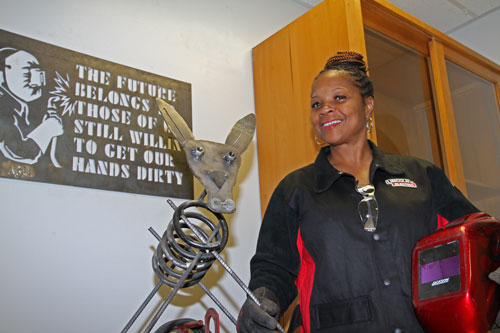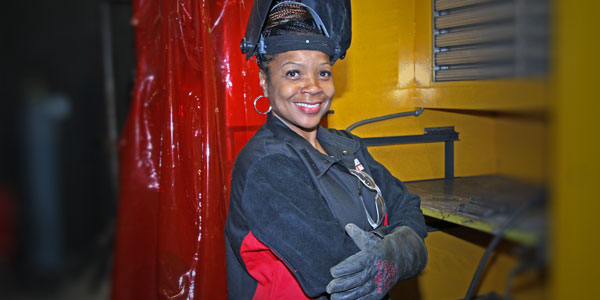Last updated on October 7, 2019
Treddie Johnson is not your typical welder.
First of all, Treddie is a woman, which immediately sets her apart from 95 percent of welders in the U.S.
Second, Treddie has cataracts, which limit her vision when working with hot flames.
Lastly, Treddie has 20 years of experience as a home health nurse.
If these statements tell you anything, let it be that Treddie Johnson is, above all other things, a warrior. She pursues her passions with fearless enthusiasm and consistently looks for opportunities to stretch herself and challenge her skills.
“I am a Chickasaw Indian,” explains Treddie. “Throughout history, Indians always have been warriors. They come back, come together and move forward. They are very resilient, and these things mean a lot to me.”
The Beginning: From Personal Trauma Grew Compassion
One of four children, Treddie’s life story has required Chickasaw resilience. She grew up in Oklahoma City, motherless, before relocating to Dallas at age 10. In her teen years Treddie encountered the ugliness of abuse in her home. Substance abuse followed.
“As a victim of abuse as a child, I felt the need to help someone because I never got the help I needed,” says Treddie.
With a compassionate heart, 18-year-old Treddie decided to pursue a career in health care and soon earned her certification as a Certified Nurses’ Aide. For the next 20 years, she traveled across Texas caring for home-bound patients, many of whom were terminally ill. The job was emotionally fulfilling for Treddie, and she enjoyed taking care of people — that was, until she realized she needed to take care of herself.
“It’s a long story, but eventually the things that happened to me as a child came to the surface,” says Treddie. “I realized I needed to make a change.”
Starting Over: A Spark of Creativity Ignited

Treddie turned to her tribal advisor at the Indian reservation for advice. One job assessment later, Treddie discovered her personality was a good match for the welding industry. Welders can be their own bosses and build things in career paths like manufacturing and construction. They can also create works of art.
“What stood out to me was the definition of welding,” explains Treddie. “It means to take two pieces of metal and join them together as one. And that power of connection and new creation stood out to me.”
Treddie decided to enroll in the Welding Technology program at El Centro College. The college’s Bill J. Priest campus was conveniently close to home, and Treddie says she trusted the college. “If I was going back to school after 20 years, I wanted to do it right. No surprises,” adds Treddie. “I knew I could afford [community college] and would get the training I needed.”
Diving In
On day one of welding classes, Treddie was excited to learn. And that initial excitement has stuck. After 11 months of classes, she is still motivated to learn more.
“I want to specialize in TIG welding,” says Treddie. “TIG is a very meticulous process — it’s almost like sewing with a needle and thread because the flame is so small.”
Treddie was introduced to TIG, or tungsten inert gas welding, and many other specialties during her Welding Technology classes at the Bill J. Priest Institute. She says the program’s hands-on classes focus less on lecture and more on developing hard skills. Every day students spend time out in the garage building real-world experience. They carry and cut steel, fuse metals together with intense heat and inspect completed projects to make sure they meet specifications. Because of this hands-on approach to learning, students tend to find employment easily.
“I got an entry-level job at Erect A-Line when I finished my welding certificate,” says Treddie. “They actually came to my classroom to say they were hiring.”
Re-adapting to Change
This March, Treddie learned she had cataracts. And, without her eyesight, she could no longer perform her job at Erect A-Line. Being her resilient self, Treddie decided to finish her spring semester at El Centro and then return to working part time as a Certified Nurses’ Aide.
Treddie’s thirst for welding, however, is far from quenched.
“For me, success means overcoming barriers,” says Treddie, who had cataract surgery in late June. “Success is way more than money for me.”
This fall, Treddie plans to study TIG welding through the continuing education program at Cedar Valley College while simultaneously pursuing an Associate in Arts. One day she hopes to own her own welding company and to be able to outsource projects.
Navigating Uncharted Territory
While some women may be afraid to explore a career field that historically has employed mostly men, Treddie Johnson advises these women to consider the benefits.
“As a woman, welding is about creating art,” explains Treddie. “You can create something beautiful when you weld, and that’s very powerful. Welding is also an outlet. It gave me a sense of belonging and emotional well-being. Before, I felt like there was a part of me that had been untouched and unknown, but welding has allowed me to discover who I am and what I can do.”
Although Treddie is comfortable working in a man’s world, it hasn’t always been easy. In the past, some of her male counterparts have been unaccommodating in the classroom. “When I would ask for help, I could tell some of [the other welders] didn’t want me there,” says Treddie. “But I just focused on what I was doing and didn’t let it distract me. Most of the guys came around.”
The biggest challenge is not gender bias, however. According to Treddie, it’s reading and sketching blueprints. Math is not one of her strengths. The intense heat that accompanies welding can also be difficult when Treddie has to repeat a welding task over and over to get it just right. But the pride and satisfaction that comes from completing the project far outweighs any momentary discomfort.
“It’s really not as hard as people make it out to be,” explains Treddie. “If you know this is what you want to do, just take it on like you would any other job or training: with enthusiasm and willingness to learn.”
